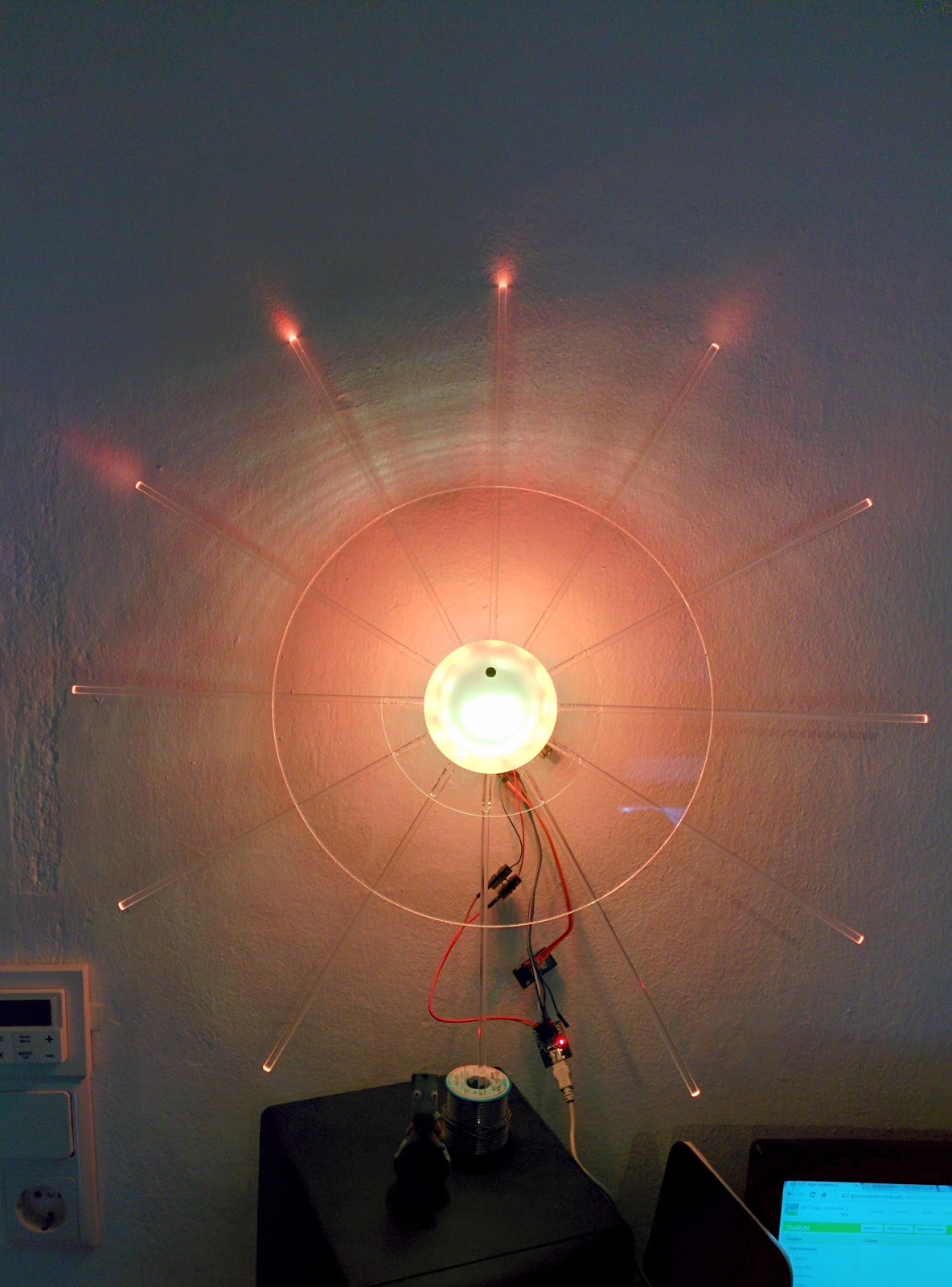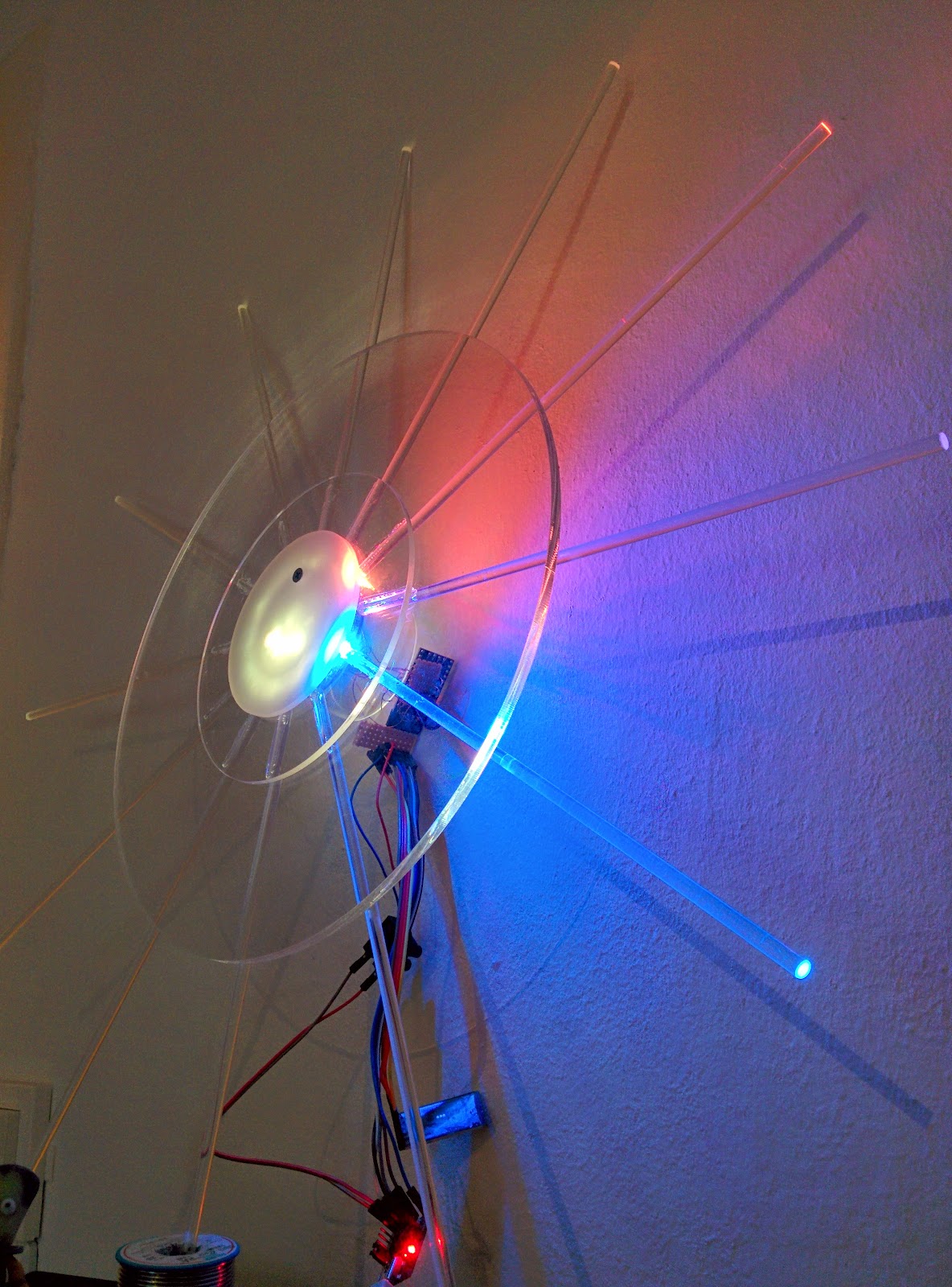The BridgeProcessing-Software
 |
| Overview in Processing |
THE CODE
This is my approach to store serial-data into a SQL Database. I will describe the RPI Setup later.
This is my approach to store serial-data into a SQL Database. I will describe the RPI Setup later.
import processing.serial.*;
import de.bezier.data.sql.*;
import java.util.*;
MySQL db;
Serial myPort; // Create object from Serial class
int myaddr = 1;
int addr;
int numeric;
int ldr;
int heat;
int light;
int node = 1;
int nodec = 1;
long setTimer = 120000;
int commandtimer = 10000;
int nrofnodes = 2;
int timerflag = 0;
int commandflag = 0;
int x = 1;
int i = 0;
int addrset;
int tempmin;
int hummin;
int lightsw;
int heatsw;
int setflag;
String TIME;
String TIMESTAMP;
String room;
float temp;
float hum;
long oldmillis;
long newmillis;
long oldcommandmillis;
long oldutchour;
long newutchour;
int utcflag = 0;
long utc;
char c;
String inData;
String[] list = new String[32];
String inDatapl;
String[] listpl = new String [32];
char utch = '@';
char sof = '#';
char dof = '/';
char plm = 'P';
char eof = '|';
char rf = '0';
char wf = '1';
char ack = '2';
char set = '3';
int flag;
void setup()
{
size(640, 360);
smooth();
String portName = Serial.list()[2];
myPort = new Serial(this, portName, 19200);
myPort.buffer(64);
myPort.bufferUntil(eof);
String user = "youruser";
String pass = "yourpass";
String database = "ahap"; //DBName
db = new MySQL( this, "localhost", database, user, pass );
}
void draw()
{
newmillis = millis();
newutchour = hour();
//serial.Event(myPort);
readSerial();
if (newmillis - oldmillis > setTimer/(nrofnodes-1) || timerflag == 0 || commandflag == 1) // || commandflag == 1
{
commandflag = 0;
timerflag = 1;
writeSerial();
oldmillis = millis();
}
if (millis() - oldcommandmillis > commandtimer/(nrofnodes-1))
{
oldcommandmillis = millis();
writeSerialCommand();
}
if (newutchour != oldutchour || utcflag == 0)
{
oldutchour = hour();
utcflag = 1;
calculateutc();
}
background(0);
textSize(20);
//int y=x+1;
text("Addresse: " + node , 50, 30);
text("Raum: " + room , 350, 30);
textSize(16);
text("Daten von: data-DB", 50, 50);
text("Daten von: data_set-DB", 350 , 50);
textSize(14);
text("Temperatur: " + temp/10, 50, 80);
text("Feuchtigkeit: " + hum/10, 50, 100);
text("Heizung: " + heat, 50, 120);
text("LDR: " + 0.1*ldr, 50, 140);
text("Licht: " + light, 50, 160);
text("letzter Kontakt: " + TIME, 50, 180);
text("Msg OUT: " + sof + addrset + dof + myaddr + dof + wf + dof + tempmin + dof + hummin + dof + lightsw + dof + heatsw + eof, 50, 240);
text("TIMEstamp: " + utch + hour() + dof + minute() + dof + second() + dof + day() + dof + month() + dof + year() + eof, 50, 280);
text("Durchlauf " + i , 50, 220);
text("Msg IN: #" + list[0] + dof + list[1] + dof + list[2] + dof + list[3] + dof + list[4] + dof + eof, 50, 260);
text("Anzahl Nodes " + nrofnodes , 50, 300);
text("Node " + node , 50, 320);
text("soll Temperatur: " + tempmin, 350, 80);
text("soll Feuchtigkeit: " + hummin, 350, 100);
text("Heizung ein/aus: " + heatsw, 350, 120);
text("Licht ein/aus: " + lightsw, 350, 140);
text("eingestellt am: " + TIMESTAMP, 350, 180);
//calculateutc();
}
void readSerial()
{
if (myPort.available() >0)
{ delay(50);
c = myPort.readChar();
if ( c == sof )
{
inData = myPort.readStringUntil(eof);
if(inData != null){
list = split(inData, "/");
print("Empfänger: ");
println(list[0]);
print("Sender: ");
addr = int(list[1]);
println(list[1]);
print("Flag: ");
println(list[2]);
flag = int(list[2]);
int listcount = list.length;
print("Listenfelder: ");
println(listcount);
if (listcount > 8){
//println("FLAG ACK ERKANNT");
print("Temperatur: ");
temp = int(list[3]);
println(temp/10);
print("Feuchtigkeit: ");
hum = int(list[4]);
println(hum/10);
print("Heizung: ");
heat = int(list[5]);
println(heat);
print("LDR: ");
ldr = int(list[6]);
println(0.1*ldr);
print("Licht: ");
light = int(list[7]);
println(light);
println(" ");
sqlset();
inData = null;
}
if (listcount < 8){
//println("FLAG SET ERKANNT");
//inData = myPort.readStringUntil(eof);
//if(inData != null){
//list = split(inData, "/");
print("Heizung: ");
heat = int(list[3]);
println(heat);
print("Licht: ");
light = int(list[4]);
println(light);
commandflag = 1;
sqlupdate();
inData = null;
}
}
}
}
else {
myPort.clear();
}
//delay(1);
//myPort.clear();
}
void writeSerial()
{ println("write Serial");
i= i+1;
if (node <= nrofnodes)
{
node++;
}
if (node == nrofnodes + 1 || node == 0)
{
node = 2;
}
db.connect();
if(db.connect() == true)
{
db.query( "SELECT COUNT(*) FROM room_set" );
db.next();
nrofnodes = db.getInt(1);
db.query( "SELECT `TIME` FROM `data` WHERE addr=('%s') ORDER BY ID DESC LIMIT 1", node);
db.next();
TIME = db.getString("TIME");
db.query( "SELECT `room` FROM `room_set` WHERE addr=('%s')", node);
db.next();
room = db.getString("room");
db.query( "SELECT `addr`, `tempmin`, `hummin`, `lightsw`, `heatsw`, `TIME` FROM `data_set` WHERE addr=('%s') ORDER BY TIME DESC LIMIT 1", node);
db.next();
addrset = db.getInt("addr");
tempmin = db.getInt("tempmin");
hummin = db.getInt("hummin");
lightsw = db.getInt("lightsw");
heatsw = db.getInt("heatsw");
TIMESTAMP = db.getString("TIME");
myPort.write(char(sof));
myPort.write(str(addrset));
myPort.write(char(dof));
myPort.write(str(myaddr));
myPort.write(char(dof));
myPort.write(str(rf));
myPort.write(char(dof));
myPort.write(str(tempmin));
myPort.write(char(dof));
myPort.write(str(hummin));
myPort.write(char(dof));
myPort.write(str(lightsw));
myPort.write(char(dof));
myPort.write(str(heatsw));
myPort.write(char(eof));
}
db.close();
}
void writeSerialCommand()
{
println("write Serial Command");
if (nodec <= nrofnodes)
{
nodec++;
}
if (nodec == nrofnodes + 1 || nodec == 0)
{
nodec = 2;
}
db.connect();
if(db.connect() == true)
{
db.query( "SELECT COUNT(*) FROM room_set" );
db.next();
nrofnodes = db.getInt(1);
db.query( "SELECT `addr`, `tempmin`, `hummin`, `lightsw`, `heatsw`, 'setflag', `TIME` FROM `data_set` WHERE addr=('%s') ORDER BY TIME DESC LIMIT 1", nodec);
db.next();
addrset = db.getInt("addr");
tempmin = db.getInt("tempmin");
hummin = db.getInt("hummin");
lightsw = db.getInt("lightsw");
heatsw = db.getInt("heatsw");
//setflag = db.getInt("setflag");
TIMESTAMP = db.getString("TIME");
// if (setflag == 1){
myPort.write(char(sof));
myPort.write(str(addrset));
myPort.write(char(dof));
myPort.write(str(myaddr));
myPort.write(char(dof));
myPort.write(str(wf));
myPort.write(char(dof));
myPort.write(str(tempmin));
myPort.write(char(dof));
myPort.write(str(hummin));
myPort.write(char(dof));
myPort.write(str(lightsw));
myPort.write(char(dof));
myPort.write(str(heatsw));
myPort.write(char(eof));
// setflag = 0;
//}
db.close();
if (x == nrofnodes)
{
x=1;
}
}
}
void sqlset()
{
db.connect();
if(db.connect() == true)
{
db.query("INSERT INTO data (addr, temp, hum, ldr, heater, light) VALUES ('%s', '%s', '%s', '%s', '%s', '%s')",addr, temp/10, hum/10, ldr*0.1, heat, light);
db.close();
}
}
void sqlupdate()
{
db.connect();
if(db.connect() == true)
{
db.query("UPDATE data_set SET heatsw =%s, lightsw =%s, setflag = %s WHERE addr='%s' ", heat, light, setflag, addr);
db.close();
}
}
void calculateutc()
{
println("calculateUTC");
delay(500);
myPort.write(char(utch));
myPort.write(str(hour()));
myPort.write(char(dof));
myPort.write(str(minute()));
myPort.write(char(dof));
myPort.write(str(second()));
myPort.write(char(dof));
myPort.write(str(day()));
myPort.write(char(dof));
myPort.write(str(month()));
myPort.write(char(dof));
myPort.write(str(year()));
myPort.write(char(eof));
delay(10);
println("TimeSET");
//myPort.clear();
}





